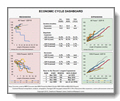Economic Cycle Dashboard
The current economic expansion, so far, is currently the fourth longest on record (out of 34 since 1854). This chart compares the duration and magnitude of the current expansion to historical averages. Economists often review the economic cycles after 1950 as a separate set. Therefore, the historical averages are presented with all years since 1854 and the years since 1950. You will see that the current expansion is considerably slower than the historical averages and slower than 90% of all past expansions.
Slow-and-steady has come at a great cost to wage growth and standards of living. Had this expansion been simply the modern average, wages and standards of living would be 18% higher today than they are after slow-and-steady! (“Expansion” is the most appropriate term for the growth period that follows a “recession.” Not only must expansions happen first–the first economic step could not have been a recession from zero!–but also recessions are periods of correction for misalignments that occur during preceding expansions. Further, the term “recovery” implies that actions might be needed to “fix” the economy from a recession, rather than to allow the natural forces of population growth and productivity to deliver economic expansion.) Nonetheless, the economy is in a race to a new longevity record: third place next March 2017 and first place in July 2019. The age of the current expansion also represents a risk for the stock market should a recession end its run.

